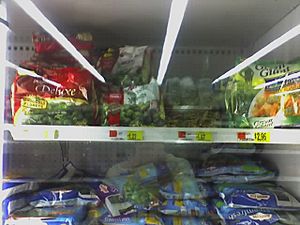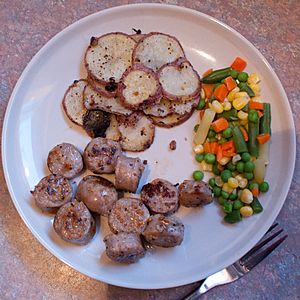Frozen vegetables facts for kids

Frozen vegetables are vegetables that have been made very cold, below their freezing point. This helps keep them fresh for a long time, much longer than if they were left at room temperature. People freeze vegetables so they can be stored and moved easily until they are ready to be cooked and eaten. You can find many different kinds of frozen vegetables in supermarkets, either in bags from companies or frozen at home.
You can buy many common vegetables frozen, like spinach, broccoli, cauliflower, peas, and corn. Sometimes, these are sold as single vegetables, or they might be mixed together in a bag. You might even find frozen vegetables mixed with other foods like pasta or cheese. Frozen fruits are made in a very similar way.
Some well-known brands that sell frozen vegetables include Birds Eye, Sunbulah, and Green Giant. Supermarkets also sell their own 'store brand' frozen vegetables.
Why Choose Frozen Vegetables?
Frozen vegetables have some cool benefits compared to fresh ones:
- They are available even when the fresh version is not in season. This means you can enjoy corn in winter!
- They last a very long time when kept in a freezer. This helps reduce food waste.
- They are often already washed and cut, and sometimes even seasoned. This saves you time in the kitchen.
- Frozen vegetables can sometimes be cheaper to buy than fresh ones.
- They are often frozen when they are perfectly ripe, which helps keep their flavor and nutrients.
A Quick History of Freezing Food
People have been freezing food for a long time! In ancient China, during the Liao Dynasty, people enjoyed "frozen" pears as a special treat.
The modern way of freezing vegetables, using a method called flash freezing, became popular in 1929. This method freezes food very quickly, which helps keep its texture and taste better. A person named Clarence Birdseye helped make this method famous.
See also
 In Spanish: Verduras congeladas para niños
In Spanish: Verduras congeladas para niños


